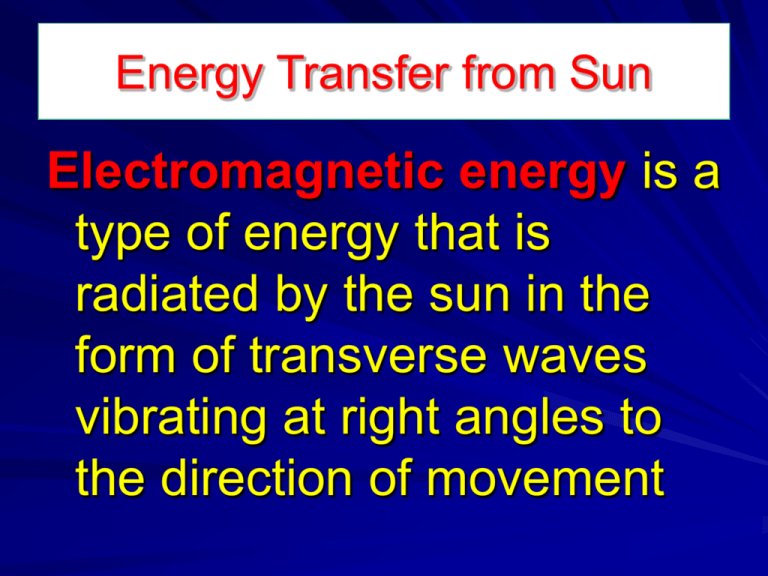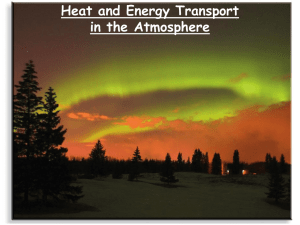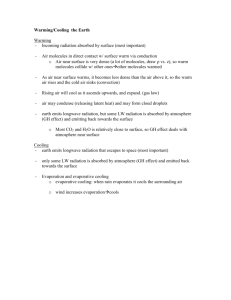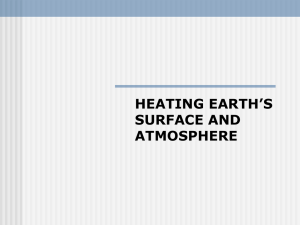Energy-Transfer
advertisement

Energy Transfer from Sun Electromagnetic energy is a type of energy that is radiated by the sun in the form of transverse waves vibrating at right angles to the direction of movement Radiation occurs in different forms identified by their wavelengths The maximum intensity of insolation occurs in the range of wavelengths of visible light INSOLATION REACHING INTERFACE BETWEEN SPACE / ATMOSPHERE IS DIFFERENT FROM THE INSOLATION REACHING EARTH’S SURFACE WHAT HAPPENS TO ELECTROMAGNETIC ENERGY (RADIATION) ONCE IT REACHES EARTH? Radiation is reflected – bounced back at the same angle they arrived Radiation is scattered – reflected in various directions Radiation is refracted - bent Radiation is transmitted – pass through the material Radiation is absorbed (taken in as heat energy) Surface Properties light vs. dark smooth vs. rough SUN EMITS MAXIMUM INTENSITY IN THE VISIBLE LIGHT RANGE EARTH EMITS MAXIMUM INTENSITY IN THE INFRARED RANGE Once energy is absorbed within the EarthAtmosphere system HEAT can be transported be 3 methods Radiation Conduction Convection Radiant Energy examples: 1. Sun warms face 2. Apparent heat of the fire CONDUCTION – MOLECULES TRANSFER KINETIC ENERGY (KE) THROUGH VIBRATIONS OR COLLISIONS SOLIDS BEST FOR CONDUCTION MOLECULES CLOSE TOGETHER CONDUCTION – HEAT TRANSFERRED BY VIBRATIONS OF ALUMINUM MOLECULES IN BAR - SOLIDS CONVECTION – HEAT TRANSFERRED BY DENSITY DIFFERENCES IN THE LIQUID – FLUIDS (LIQUIDS – ATMOSPHERE) CONVECTION OCCURS IN THE ATMOSPHERE CONDUCTION HEATS ONLY THE LOWEST ATMOSPHERE TOUCHING EARTH’S SURFACE (UP TO ABOUT 6 FT.) CONVECTION CAUSES AIR TO RISE DUE TO DENSITY DIFFERENCES EARTH ABSORBS SHORTWAVE RADIATION EARTH EMITS LONGWAVE RADIATION – TERRESRIAL INFRARED RADIATION TROPOSPHERE IS MAINLY HEATED BY RERADIATED TERRESTRIAL INFRARED RADIATION FROM EARTH “GREENHOUSE EFFECT” GREENHOUSE GASES CARBON DIOXIDE AND METHANE THE BURNING OF FOSSIL FUELS Life on Earth due to Greenhouse Effect Earth is the “Goldilocks Planet” – just right – average temperature is 59° F (w/o GE our average temperature would be -3° F) Mars’ average temperature is -67° F (1/5 of our atmosphere) Venus’ average temperature due to GE is 855° F Mercury’s temperature 333° F RADIATION BALANCE DYNAMIC EQUILIBRIUM INPUT = OUTPUT Is global warming changing the balance??????? Water heats up more slowly mainly due to its high Specific Heat (takes 5 x longer than land) MODERATING EFFECT OF LARGE BODIES OF WATER By Charles Burrow s 50 90 45 80 40 70 35 60 30 50 25 40 20 30 15 20 10 5 10 0 0 9.62 7.87 7.37 4.93 3.28 2.57 1.16 MONTH 1.21 2.61 5.61 10.5 10.4 AVERAGE TEMPERATURE (F) AVERAGE PRECIPITATION (inches) CLIMOGRAPHS: 30-YEAR AVERAGES (1971 - 2000) AKRON, OH SAN DIEGO, CA ABERDEEN, SD CHARLESTON AP,SC AKRON, OH SAN DIEGO, CA ABERDEEN, SD CHARLESTON AP,SC 2 types of Heat Energy Kinetic Energy – is energy in motion. Temperature is the average KE of molecules Potential Energy – is energy in storage aka latent heat or hidden energy. Cannot be measured with a thermometer Change in State (Phase Change) Change in state is a change in potential energy Known as latent heat because it does not cause a temperature change During the phase change energy can be absorbed or released but the energy is hidden because it DOES NOT SHOW A CHANGE IN TEMPERATURE DURING CHANGE OF STATE, ENERGY IS CONVERTED TO POTENTIAL ENERGY OR STORED HEAT – DOES NOT SHOW A CHANGE IN TEMPERATURE Condensation and freezing – release energy Evaporation and melting – require energy ¾ OF THE ENERGY ABSORBED BY EARTH EVAPORATES WATER FROM THE OCEANS EVAPORATION 540 CALORIES/GRAM GAINED The gram of water absorbed 540 calories of latent heat as it changed to vapor (require addition of energy) COOLING EFFECT CONDENSATION 540 CALORIES/GRAM RELEASED The gram of water released 540 calories of latent heat as it changed to liquid (give off energy) WARMING EFFECT




![Applied Heat Transfer [Opens in New Window]](http://s3.studylib.net/store/data/008526779_1-b12564ed87263f3384d65f395321d919-300x300.png)

